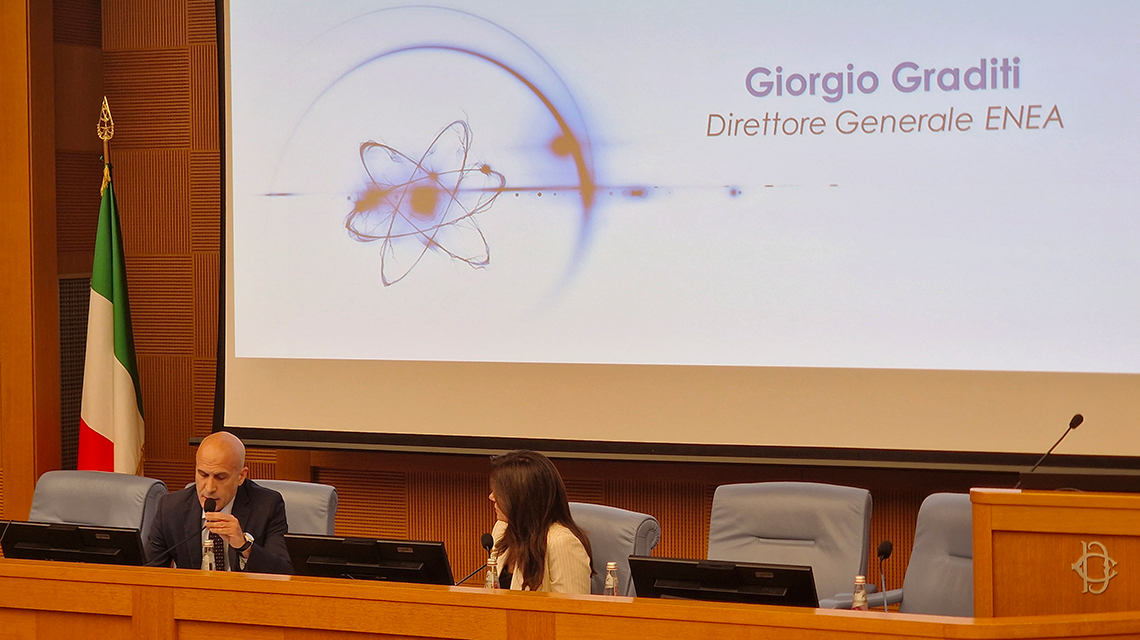Italian National Agency for New Technologies, Energy and Sustainable Economic Development

Nuclear power: Confindustria and ENEA published report on technologies, costs and impacts
Confindustria and ENEA jointly presented the report “The Development of Nuclear Energy in the National Energy Mix – The Potential forthe Italian Industry”, a document outlining a strategy to reintegrate nuclear power into Italy’s energy mix in line with decarbonization, energy security, and industrial competitiveness goals. Among the main advantages of new technologies are: minimal carbon emissions throughout the entire life cycle, dispatchable production of electricity and heat, low fuel requirements, reduced waste generation, stable energy costs marginally unaffected by raw material price volatility, and improved grid reliability without additional distribution costs.
As for the economic aspects of the two proposed plant typesinvestigated (Small Modular Reactors and Advanced Modular Reactors), the study estimates the creation of around 117,000 new jobs, including 39,000 directly within the supply chain. According to the analyzed scenarios, with a first plant operational by 2035, nuclear energy will prove advantageous both economically and energetically, providing significant benefits for industry, especially for those high-temperature processes that are difficult to decarbonize. The report also highlights the effectiveness of an appropriate system of incentives for nuclear energy, following the example of renewable energy sources.
HIGHLIGHTS
Technologies – The introduction of advanced and sustainable nuclear energy in Italy, alongside renewables, is based on next-generation technologies, capable of meeting environmental and energy security objectives. These technologies while bringing along benefits such as lower costs for citizens and businesses, reduced land use, greater grid stability and safety, and closer proximity between production sites and consumption centers. The technologies underpinning this revivaltransformation are:
SMR (Small Modular Reactor): small-scale modular reactors that are more flexible, safer, and suitable for medium-to-high-temperature cogeneration. They offer advantages in terms of costs, installation times, and grid stability.
AMR (Advanced Modular Reactor): advanced, high-efficiency modular reactors that complement SMRs, capable of recycling spent fuel from SMRs and providing high-temperature process heat for industrial applications.
Key features:
- Minimal greenhouse gases emissions throughout the entire life cycle;
- Dispatchable and stable production of electricity and heat in cogeneration mode;
- Minimal Very low fuel requirements (allowing for easy storage of strategic reserves) and low waste generation;
- Energy costs only marginally affected by fuel prices, thus stable and predictable;
- Increased grid stability, safety, and reliability without additional distribution costs.
Roadmap – The roadmap outlined in the report foresees the implementation of a fleet of SMR-type nuclear reactors—given their higher technological maturity—supplemented, as soon as available, by AMR systems, to fully exploit their respective unique, synergistic, and complementary characteristics.
Economic aspects – Based on IEA studies, the levelized cost of electricity for SMR and AMR plants is estimated between 70 and 110 USD/MWh, comparable to that of renewable sources (when storage costs are included). According to the report, nuclear energy development could generate an economic return equal to 2.5% of national GDP and create 117,000 new jobs, of which 39,000 directly within the national supply chain.
Over 70 Italian companies are already operateing in the nuclear field. This existing industrial base, if properly supported, could become a driving force for the expansion of the national nuclear value chain. Several companies affiliated with Confindustria have expressed interest in extending their business into the nuclear sector. To relaunch nuclear research also at industrial scale support both industrial and research revival in the nuclear field, some investment plans are already in place, such as the Nuclear Research Plan.
Education, Research Support, and Communication – Implementing a sustainable nuclear program in Italy requires an integrated approach involving strong connections between industry, research, education, and training. To this end, the document emphasizes the urgency of a national training plan to qualify technicians and professionals at all educational levels (secondary and university) and across various disciplines (engineering, law, chemistry, physics, management).
The plan shall ould involve universities, technical and professionalvocational institutes, research bodies, and interested companies, to strengthen education training at all levels and promote hands-ontraining learning opportunities, including for professionals from other sectors, ensuring a workforce that is well-prepared and continuously updated.
To maintain international competitiveness, public support for research is essential in order to increase investments and strengthen infrastructures.
Studies and surveys show a growing support to for nuclear energy, but also a widespread lack of information. In this context, clear, accessible, transparent, and evidence-based communication is essential to foster informed debate and active participation. The isshould include engagement ing of all stakeholders and thepromotiong of an accurate narrative are key pillars to that provides the public with the basic knowledge needed to approach the topic with greater awareness.
It is crucial to establish educational and science outreach programs and to develop a culture of energy sustainability, drawing on the experiences of countries where the public understanding of nuclear benefits has improved its social acceptability.
